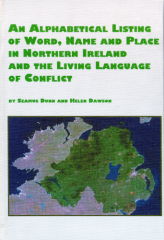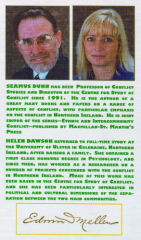
Extract from 'An Alphabetical Listing of Word, Name and Place in Northern Ireland' by Seamus Dunn & Helen Dawson (2000)[Key_Events] Key_Issues] [Conflict_Background] The following extract has been contributed by the authors Seamus Dunn and Helen Dawson, with the permission of the publisher, Edwin Mellen Press. The views expressed in this chapter do not necessarily reflect the views of the members of the CAIN Project. The CAIN Project would welcome other material which meets our guidelines for contributions.  This extract is taken from the book:
This extract is taken from the book:
AN ALPHABETICAL LISTING
Orders to local bookshops or:
This publication is copyright Seamus Dunn and Helen Dawson (2000) and is included on the CAIN site by permission of Edwin Mellen Press and the authors. You may not edit, adapt,
or redistribute changed versions of this for other than your personal use without express written permission. Redistribution for commercial purposes is not permitted.

NOTES ON TERMINOLOGY The lead words in the book are in alphabetical order and are printed in bold capitals. Where lead words occur within an entry for the first time they are printed in italics. The words Catholic and Protestant are capitalised throughout the book while the words nationalist, republican, unionist and loyalist are in lower case except when any of them refers to a political party or other formal organisation. The word Catholic is used to mean Roman Catholic and the word Derry to mean Londonderry. Every attempt has been made to ensure that the information contained in this book is accurate, but the authors regret any discrepancies or inaccuracies that may have occurred.
GAA SEE GAELIC ATHLETIC ASSOCIATION
GAELIC ATHLETIC ASSOCIATION (GAA) The GAA was founded on 1st November 1884 in County Tipperary as an amateur sporting association, to preserve and encourage national sports. It also included in its aspirations the need to promote all aspects of Irish culture. The organisation quickly spread all over the country, including the north, and became and has remained the largest amateur sporting organisation in Ireland. GAELIC LANGUAGE SEE LANGUAGE GAME The conflict is not often referred to directly as a game, but phrases such as zero-sum game, and win-win game (with its other variations: win-lose; lose-lose) are often heard. GANSTERS IN SUITS SEE ARMANI GARVAGHY ROAD A Catholic/nationalist area in the mainly Protestant town of Portadown. It became very well known as a consequence of the outbreaks of violence associated with the annual disputed Orange Order parade at Drumcree. GARVAGHY ROAD RESIDENTS COALITION (GRRC) Umbrella group set up in 1995 by the residents of the predominately Catholic Garvaghy Road to oppose the Orange Order march down that road. The lawyer Rosemary Nelson, who represented the GRRC, was murdered by the loyalist group the Red Hand Defenders on 15th March 1999. GAS SEE CS GAS GENOCIDE Protestants living in the border areas between Northern Ireland and the Republic of Ireland often seemed to be particularly targeted. Many were killed and many others left their homes and farms and moved to safer areas. This process was sometimes described by unionists as a form of genocide, and also as ethnic cleansing. GERRYMANDERING This means the manipulation of voting districts/electoral boundaries to benefit a particular candidate or party. It is often associated in Northern Ireland with unionist manipulation of boundaries from the setting up of the state in the 1920s and beyond. The Cameron Commission in 1969 found that in the case of housing allocation, unionists had manipulated ward boundaries for political and sectarian ends. The cause celebre in relation to gerrymandering has always been the city of Derry/Londonderry where careful boundary management and a process of ghettoising ensured a unionist political majority in a predominately nationalist city. GFA SEE GOOD FRIDAY AGREEMENT GIBRALTAR The Gibraltar or Death on the Rock killings refers to the killing of three PIRA members by undercover members of the SAS in Gibraltar on 6th March 1988. Controversy surrounded the killings when it was discovered that the three were unarmed and did not have explosives as originally reported by the Ministry of Defence. Subsequently, on the day of the funerals, a loyalist paramilitary called Michael Stone shot and killed three mourners attending the funerals in Milltown Cemetery, Belfast. A few days later at the funeral of one of those killed at Milltown cemetery, two corporals in the British Army were attacked by mourners and later murdered by the PIRA. In September 1995 the European Court of Human Rights ruled that the Gibraltar killings breached Article 2 of the Convention of Human Rights. This ruling overturned previous findings that the killings were not unlawful. The British government complied with the courts decision and awarded legal costs to the families of the three amounting to £40,000. GLEBE HOUSE SEE HARMONY COMMUNITY TRUST GLENCREE CENTRE FOR RECONCILIATION This reconciliation group was established in 1973 and re-established in 1994 to try to build peace within the Republic of Ireland, and between it and its neighbours in Northern Ireland. Situated in the Wicklow mountains in the Republic of Ireland, Glencree runs a peace studies programme, exchange visits and workshops. GLORIOUS TWELFTH This refers to the Twelfth of July, the most important day of the year for Orangemen and their supporters. Each year 18 major parades are organised to celebrate the Battle of the Boyne. GOD SEE FOR GOD AND ULSTER GODFATHERS OF VIOLENCE This phrase was much used as a way of describing the organisers and planners of violence. The implication was that young people were exploited and used to carry out bombings and shootings while the leaders stayed nut of sight. GOOD FRIDAY AGREEMENT (GFA) After months of negotiations the Northern Ireland multi-party talks concluded on 10th April 1998 with an agreement, to become known as the Good Friday Agreement or the Belfast Agreement. Ten political parties took part in the talks process; the Alliance Party, Labour, Northern Ireland Womens Coalition, Progressive Unionist Party (PUP), Sinn Féin, Social Democratic and Labour Party (SDLP), Ulster Democratic Party (UDP), Democratic Unionist Party (DUP), United Kingdom Unionist Party (UKUP) and the Ulster Unionist Party (UUP). Two parties walked out of the talks on 16th July 1997 and refused to return in protest over decommissioning. These were the DUP led by Rev Ian Paisley and the UKUP led by Bob McCartney. The Agreement was submitted to referenda in the North and South on 22nd May 1998. In the North it was passed with over 70 per cent in favour. In the South 94 per cent voted to change Articles 2 and 3 of the Irish Constitution. GOVERNMENT DEPARTMENTS During the period of Direct Rule, beginning in 1972, there were six government departments: Department of the Environment (DOE); Department of Economic Development (DED; Department of Education (DENI); Department of Health and Social Services (DHSS); Department of Finance and Personnel (DFP) and the Department of Agriculture (DANI). GOVERNMENT LEADERS In the months of negotiations leading up to the Good Friday Agreement, the leaders of the three governments of Ireland, the United Kingdom and America made a vital contribution in keeping the momentum of the peace process going. The efforts of these leaders, Bertie Ahern, Tony Blair and Bill Clinton, who became known as the ABC trio, was greatly acknowledged by many. GOVERNMENT OF IRELAND ACT Passed in 1920, the Act partitioned Ireland establishing the jurisdictions of Northern Ireland and the Irish Free State (later the Republic of Ireland). GRAFFITI Slogans, catchphrases, graffiti, nicknames, terms of abuse, all overlap to some degree. Among the best-known graffiti are: any Catholic will do (ACWD), any taigs a target (ATAT), sniper at work, not a bullet - not an ounce, not an inch. GRANT CULTURE During the Troubles there was considerable growth in the number of bodies in the voluntary sector (that is non-government organisations), especially in relation to organisations involved in community relations, peace and conflict resolution. Most of these depended on grants from a variety of sources, and this led to what became known as a grant culture. GRASS SEE TERMS OF ABUSE GREEN BOOK The name of the manual given to IRA volunteers. The long-term objective is there described as the establishment of a Democratic Socialist Republic. The enemy is categorised as establishment politicians, media, judiciary, certain business elements, and the British war machine comprising the British Army, the UDR, RUC, RUC (reserve), Screws, (meaning prison officers) and Civilian Searchers. All of these, and more, were targets for execution. The manual uses the words Volunteers are trained to kill people. GREEN CROSS Charitable trust for republican political prisoners, based in Belfast. The equivalent in Dublin is called Cumann Cabrach (society of helpers). GREYSTEEL Location of a pub attack by the UFF on 30th October 1993 in which seven people were shot dead and 13 injured, one of whom died six months later. It was the beginning of the Halloween weekend when gunmen burst in, one shouting trick or treat as they opened fire on the customers. The murders that took place one week after the Shankill Road bomb were said to be in retaliation. Four UFF members were given eight life sentences for their part in the murders in February 1995. GRRC SEE GARVAGHY ROAD RESIDENTS COALITION GUBU This is an acronym for grotesque, unbelievable, bizarre and unprecedented: 1982 was said to be the year of the GUBU. It was coined by Conor Cruise OBrien after the Taoiseach Charles Haughey used the term to describe the discovery of a killer in the Attorney Generals flat. GUBU came to be used to describe all scandals involving Haughey. GUILDFORD The scene of two PIRA no-warning pub bombs on 5th October 1974, where five people died, including two soldiers, and 54 were injured. In October 1975 four people were found guilty of the bombings and later in 1976 seven members of the Maguire family were convicted for the bombings. Originally claimed by an organisation calling itself Red Flag 74. This was thought to be a cover name for the PIRA. GUILDFORD FOUR On 19th October 1989, after 14 years in jail, three of the people who had been accused of the Guildford pub bombs of 1974 were released. The Court of Appeal ruled that the police had fabricated confessions, which had led to the convictions, and that the Director of Public Prosecutions had suppressed evidence that conflicted with the confessions. The fourth member, Paul Hill, remained in prison on another charge; he was taken to Belfast by the RUC, was held overnight, and then released after a hearing lasting less than ten minutes. This conviction was also quashed on 21st April 1994. A report into the wrongful convictions by Sir John May in June 1994 stated that the miscarriages of justice were the result of individual failings rather than a fault in the criminal justice system. GUNS SEE LEGALLY HELD GUNS, DECOMMISSIONING
|
CAIN
contains information and source material on the conflict
and politics in Northern Ireland. CAIN is based within Ulster University. |
|
|
|||
|
Last modified :
|
||
|
| ||